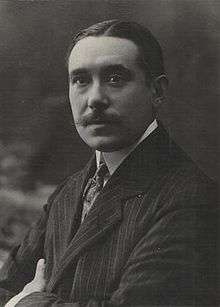Joaquín Turina
Joaquín Turina Pérez (9 December 1882 – 14 January 1949) was a Spanish composer of classical music.[1]
Joaquín Turina | |
|---|---|
 Turina in 1914 | |
| Born | 9 December 1882 |
| Died | 14 January 1949 (aged 66) Madrid, Spain |
| Occupation | Composer |
Biography
Turina was born in Seville. He studied in Seville as well as in Madrid. He lived in Paris from 1905 to 1914 where he took composition lessons from Vincent d'Indy at his Schola Cantorum de Paris and studied the piano under Moritz Moszkowski. Like his countryman and friend, Manuel de Falla, while there he got to know the impressionist composers Maurice Ravel and Claude Debussy.[2]
On 10 December 1908 he married Obdulia Garzón[3] and together they had five children. She was the dedicatee of the Danzas fantásticas, which he completed in 1919.
Along with de Falla, he returned to Madrid in 1914, working as a composer, teacher and critic. On 28 March 1916, he joined the Madrid Symphony Orchestra at the Hotel Ritz in that city, to perform the premiere of Falla's revised orchestral version of El amor brujo.[3] In the early months of 1929, he visited Havana, Cuba, where he gave a series of seven lectures at the Hispanic-Cuban Institute of Culture.[3]
In 1931 he was made professor of composition at the Madrid Royal Conservatory. He died in Madrid.[4] Among his notable pupils were Vicente Asencio and Celedonio Romero.
His works include the operas Margot (1914) and Jardín de Oriente (1923), the Danzas fantásticas (1919, versions for piano and orchestra), La oración del torero (written first for a lute quartet, then string quartet, then string orchestra), chamber music, piano works, guitar pieces and songs. Much of his work shows the influence of traditional Andalusian music. He also wrote a short one-movement Rapsodia sinfónica (1931) for piano and orchestra. His music often conveys a feeling of rapture or exaltation. His guitar works include Fandanguillo and Hommage à Tárrega, which were written for Andrés Segovia. The dedicatee and/or first performer of a number of his piano works was José Cubiles.[3]
Compositions
See: List of compositions by Joaquín Turina
References
- Encyclopædia Britannica online (2014). "Joaquín Turina"
- Marco, Tomás (1993). Spanish Music in the Twentieth Century, pp. 36–44. Harvard University Press
- Romero, Justo (2004). Piano Music, Vol. 1 (CD). Jordi Masó. Naxos. p. 3. 8.557150.
- Draayer, Suzanne Rhodes (2009). Art Song Composers of Spain: An Encyclopedia, pp. 320–330. Scarecrow Press